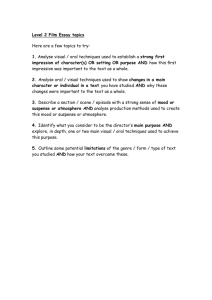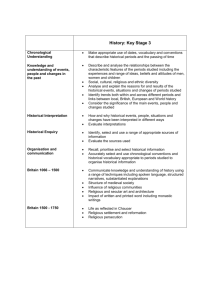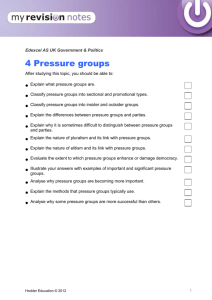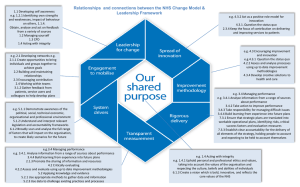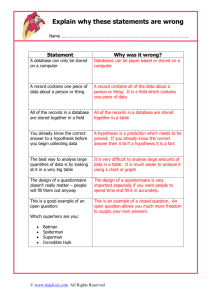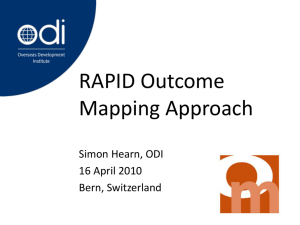Takapuna Grammar School 2011 Level 2 English (2.5) 90379 (v2
advertisement
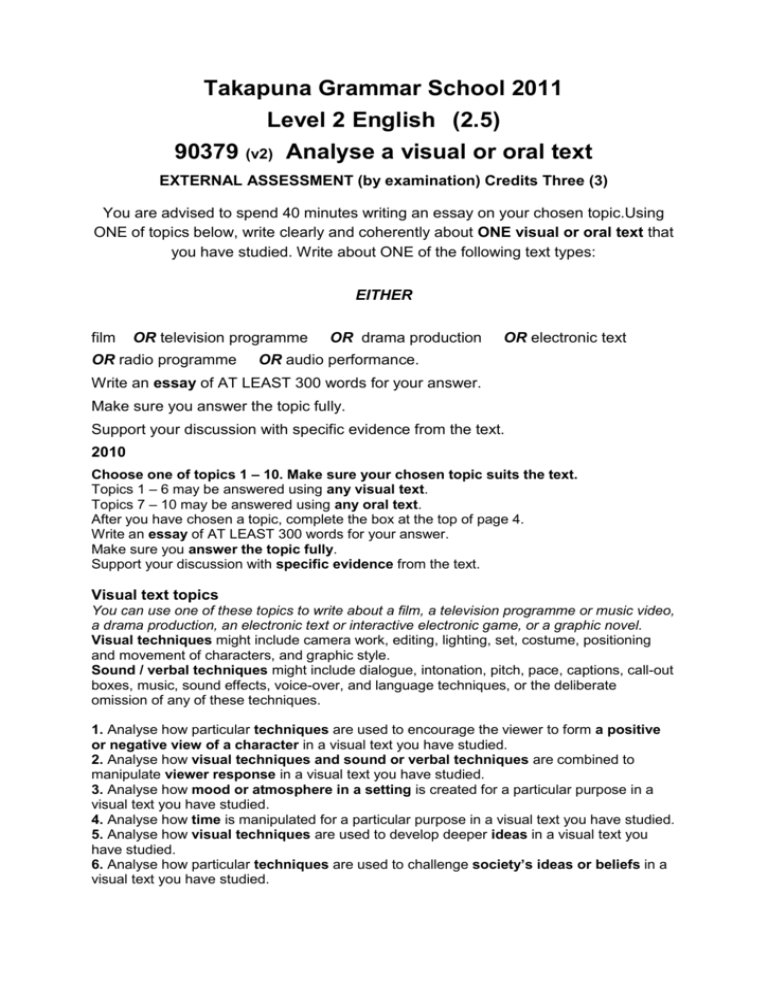
Takapuna Grammar School 2011 Level 2 English (2.5) 90379 (v2) Analyse a visual or oral text EXTERNAL ASSESSMENT (by examination) Credits Three (3) You are advised to spend 40 minutes writing an essay on your chosen topic.Using ONE of topics below, write clearly and coherently about ONE visual or oral text that you have studied. Write about ONE of the following text types: EITHER film OR television programme OR radio programme OR drama production OR electronic text OR audio performance. Write an essay of AT LEAST 300 words for your answer. Make sure you answer the topic fully. Support your discussion with specific evidence from the text. 2010 Choose one of topics 1 – 10. Make sure your chosen topic suits the text. Topics 1 – 6 may be answered using any visual text. Topics 7 – 10 may be answered using any oral text. After you have chosen a topic, complete the box at the top of page 4. Write an essay of AT LEAST 300 words for your answer. Make sure you answer the topic fully. Support your discussion with specific evidence from the text. Visual text topics You can use one of these topics to write about a film, a television programme or music video, a drama production, an electronic text or interactive electronic game, or a graphic novel. Visual techniques might include camera work, editing, lighting, set, costume, positioning and movement of characters, and graphic style. Sound / verbal techniques might include dialogue, intonation, pitch, pace, captions, call-out boxes, music, sound effects, voice-over, and language techniques, or the deliberate omission of any of these techniques. 1. Analyse how particular techniques are used to encourage the viewer to form a positive or negative view of a character in a visual text you have studied. 2. Analyse how visual techniques and sound or verbal techniques are combined to manipulate viewer response in a visual text you have studied. 3. Analyse how mood or atmosphere in a setting is created for a particular purpose in a visual text you have studied. 4. Analyse how time is manipulated for a particular purpose in a visual text you have studied. 5. Analyse how visual techniques are used to develop deeper ideas in a visual text you have studied. 6. Analyse how particular techniques are used to challenge society’s ideas or beliefs in a visual text you have studied. 2009 VISUAL TEXT TOPICS You can use one of these topics to write about a film, a television programme or music video, a drama production, an electronic text or interactive electronic game, or a graphic novel. 1. In visual texts, characters are developed through aspects such as set, props, positioning and movement of actors, costume / make-up, framing, lighting, camera techniques, and sound. Analyse how a character is developed in a visual text you have studied. 2. In visual texts, editing decisions about aspects such as camera shots and techniques, sequencing, and sound are significant both within scenes and at the points where scenes change. Analyse how editing decisions and techniques create impact in a visual text you have studied. 3. The beginning and ending scenes of a visual text are significant to the development of ideas in the text as a whole. Analyse how the beginning and ending scenes work together to develop one or more ideas in a visual text you have studied. 4. The structure of a visual text is often arranged for effect. Analyse how the story is arranged in a visual text you have studied, and explore how this creates impact. 5. Visual texts often use the conventions of genre to amuse the audience, create a mood, or develop an idea. Analyse how the director of a visual text you have studied uses the conventions of one or more genres to create particular effects. 6. In visual texts, mood can be created through aspects such as colour, shading, lighting, line, proportion, shape, costume, symbols, genre, camera techniques, and soundtrack. Analyse how mood is created in a visual text you have studied. 2008 TOPICS (Choose ONE) 1. Analyse how techniques were used to create a strong impression of at least ONE character or individual. 2. Analyse how the presentation of at least ONE setting helped develop an important theme. 3. Analyse how BOTH internal and external conflict were important to the text as a whole. Note: “internal conflict” means conflict within a character, and “external conflict” means conflict between a character and other individual(s) or group(s). 4. Analyse how techniques were used to create impact in ONE important section. 5. Analyse how the text influenced the audience to think differently about an idea or issue. 6. Analyse how the text is typical of its genre. Note: “genre” might include science fiction, romance, drama, documentary, political speech, etc. Achievement Analyse specified aspect(s) of a visual or oral text, using supporting evidence. Achievement with Merit Achievement with Excellence Analyse specified aspect(s) Analyse specified aspect(s) of a visual or oral text of a visual or oral text convincingly, using convincingly and with insight, supporting evidence. using supporting evidence. ‘No Achievement’ aspects could include: rote-learned responses, disproportionate plot summary, lacks sufficient reference to text details / specifics, insufficiently linked to the topic, does not adequately address the topic, short (less than 250 words), simplistic.
